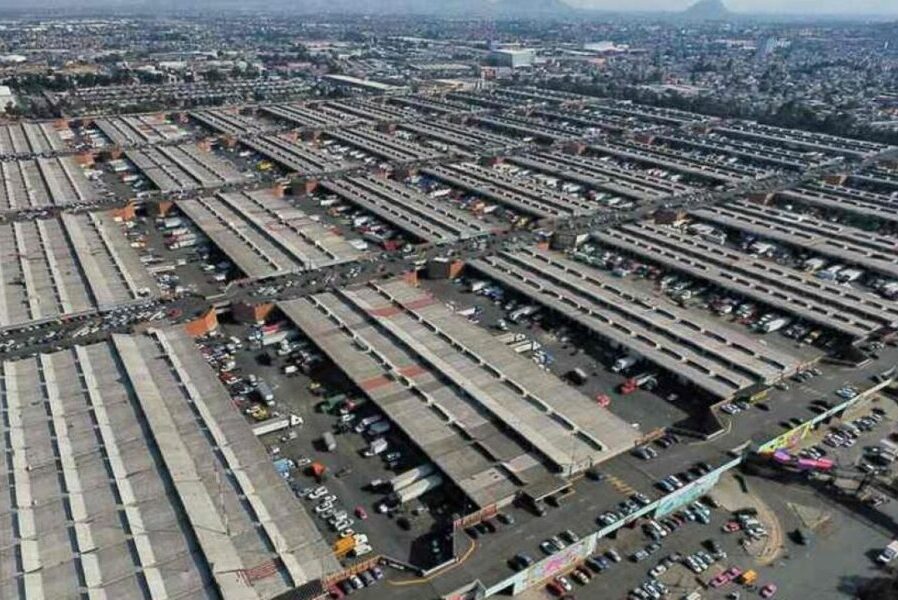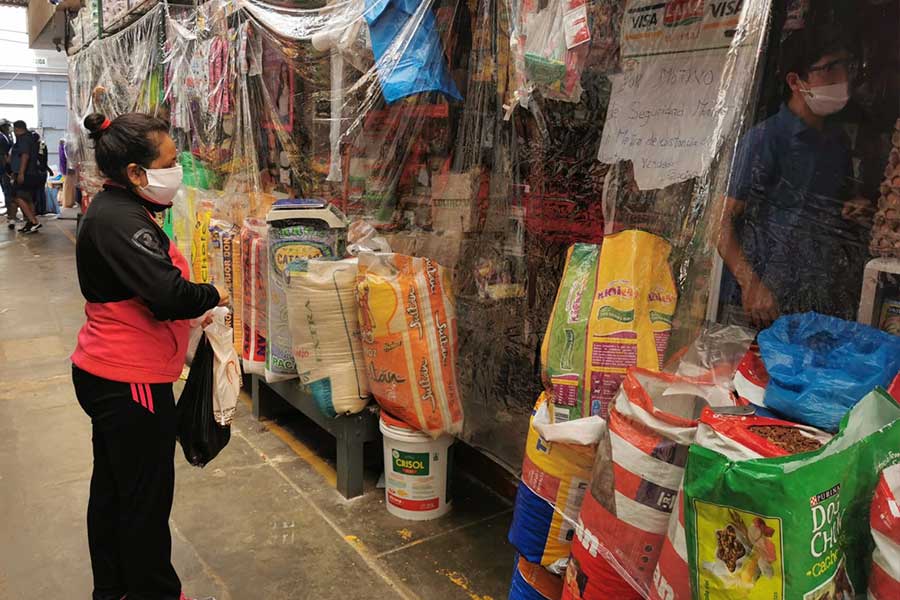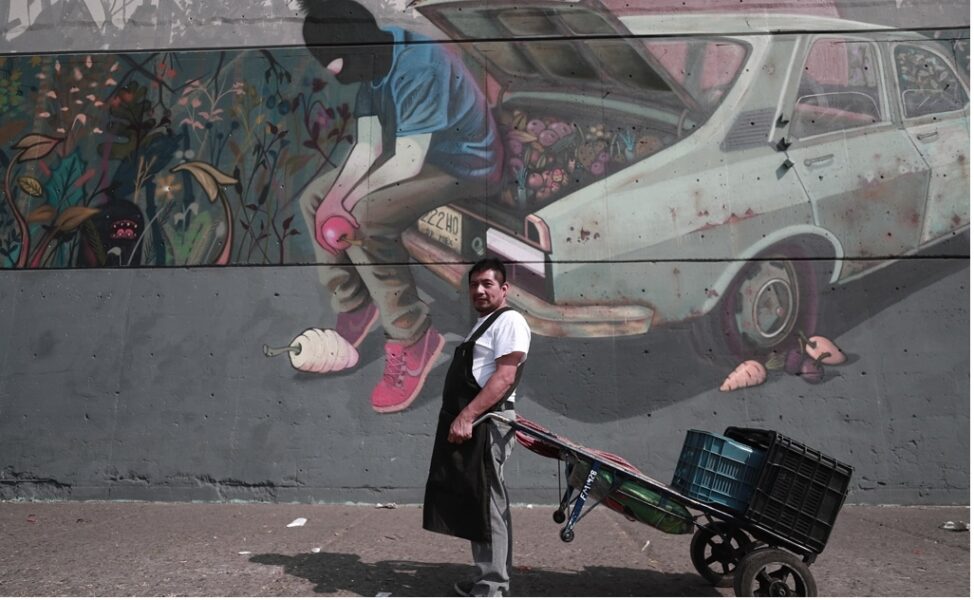¿What is the supply center of Mexico City? What is its function? Does it help the Mexican economy? We invite you to know all this information in the following article, as well as other information that you should keep in mind if you want to enter this great market.

Central supply of Mexico City
What is a supply center?
Also known as CEDA, it is a retail and wholesale market located in Mexico City, specifically in the Iztapalapa mayor's office, where you can find groceries, legumes, vegetables, meat, seafood, groceries, fruits, flowers, poultry, fish and foliage of great type.
Today, it has managed to become the second place with the largest flow of money in Mexico, after the Mexican Stock Exchange, in addition to being the largest market in the world.
The CEBA or supply center of Mexico City is located in the delimitation of the avenues Eje 4 Oriente Canal Río Churubusco, Eje 5 Sur Leyes de Reforma, Eje 5 Oriente Lic. Javier Rojo Gómez and Eje 6 Sur Social Workers, In addition, it is close to the Aculco and Apatalco stations of the subway line number eight.
In its surroundings there are also more than 27 private collective transport lines or routes, five public transport routes and a trolleybus stop.

Aerial view of the Central de Abasto de México
Origin and history of the Central de Abastos de México
Since the XNUMXth century, Mexico City has become one of the main commercial centers in the country, concentrating commerce in small public places distributed throughout the territory, called markets. All this trade began in the main square of Mexico-Tlatelolco, where the Mexican government was included after the conquest and from where the administration of the Spanish conquerors began, in New Spain.
All that commercial activity of large quantities of product was destined to the members that constituted the Consulate of Merchants of Mexico, which began in the Mercado del Parián de México and later from the Mercado de la Plaza del Volador, a control in the trade of Viceroyalty.
When the Independence of Mexico arrived, during the XNUMXth century, the consulate began to lose control due to the laws established by the new Mexican Republic, the Mercado de Volador being surpassed, due to the incredible increase in trade that came from the east of the country.
It was when small commercial premises began to appear in La Merced and where the producer could be found for retail or wholesale. However, each of these stores began to be located in streets according to the type of items they offered, generating a great impact on the social culture of the inhabitants and the creation of different brotherhoods or brotherhoods to control the market.
The specialist neighborhoods?
It is when the specialist neighborhoods begin to be known, which, as their name implies, were streets or groups of stores that would offer the same star products.
A great example is the Calzada de la Viga, which began as a wholesale store for seafood and fish, and then began with legumes, vegetables, flowers and fruits from Cuernavaca or Xochimilco and who used the Canal de la Viga to be able to move. towards your destination.
In this way, it became one of the most important commercial centers in the country, generating a great economic opportunity and even immigration from the east.
Creation of the first shopping center
In 1923, the first shopping center was created in this area, in the demolished facilities of the Merced Agreement. Created with the purpose of being able to locate in a space, the vendors that were scattered in the streets and not so much to obtain important economic advances.
Later, in 1957, the Merced Central Market was inaugurated, which consisted of two warehouses of approximately 88 thousand square meters and which had a cost of 75 million pesos to concentrate the largest number of wholesalers in the area.
However, due to the growth that Mexico City experienced in the XNUMXth century, the Merced market became a commercial center for the retail and wholesale of merchandise in general, increasing the amount of passenger and merchandise transport to be able to comply with the supply.
This growth also generated the creation of an urban reorganization plan by the Mexican government, centralizing all services and designing new viable routes for the movement of inhabitants.
Basis of the design of the Supply Center of Mexico City
Based on a design where the suburban point of the area was the main feature and had the opportunity to generate a fluid circulation of trucks, the architect Abraham Zabludovsky was in charge of creating the project that would cover all the needs that existed, in the Chinampera area. .
However, the choice of this area caused great inconvenience with the defenders of nature and the ecosystem, so they ended up designing a construction in the form of a deformed hexagonal polygon, with an approximate axis of 2250 meters and whose exits and entrances were located at the ends of the construction. Since this enclosure was aimed at wholesale, it had specially acclimatized warehouses, banks, police areas and much more.
Its construction began in March 1981 and ended on November 24, 1982, with the inauguration by President José López Portillo, however, its occupation was carried out slowly and slowly.
By 1990, the various vegetable and grocery stores were able to fill up. For the XNUMXst century, the transfer and sale of meat products, seafood, poultry and fish began, this being one of the processes that today does not end.

Aisle of the supply center of Mexico City
Characteristics of the supply center
- It has an area of 327 hectares, distributed to store more than 120 thousand tons of food and 30 thousand tons for sale.
- You can find a large number of plant and animal products, among others.
- It is visited by more than 300 thousand people daily.
- There are about 70 employees on the entire surface of the market.
- Due to its size, it is followed by the Rungis Market in France (232 hectares) and the MercaMadrid in Spain with (176 hectares).
- Vegetables and fruits have 1881 warehouses, provisions and groceries with 338 warehouses, in addition to 1489 commercial premises.
- Among the commercial premises are: laundries, banks, restaurants, aesthetics, hardware stores, among others.
- It has an auction area.
- The profile of most sellers in this market focuses on people between 25 and 44 years of age, whose educational level does not go beyond high school but have great business skills.
- It has a recycling program for boxes, wood and plastic.
- It has an overnight area of approximately 5.1 hectares, designed to park 424 cargo trucks, a heated warehouse, as well as basic services for truck drivers and helpers.
Organization of the supply center of Mexico City
The central de abastos of Mexico City has warehouses five meters wide and twenty meters long, whose front borders the west-east pedestrian corridor, this place is where buyers can go from one place to another without restrictions. with the diableros and human trafficking.
The other side borders the platforms to facilitate the unloading and loading of merchandise, being completely open to place up to two trailers per cubicle, without the risk of disturbing anyone.
The pedestrian corridors border two rows of warehouses, located on each side of it and are identified as north warehouse and south warehouse, accompanied by a letter of the alphabet. In addition, each of these wineries has a number that identifies the premises.
Between each of the platforms, the corridors are usually connected by means of bridges and are popularly known for the danger that exists with the diableros.
Popular CEDA characters
One of the striking characteristics that the center has for the guests, are undoubtedly the people that we can find in its facilities:
- Owners, winemakers or managers of the wineries: They are responsible for each of the cubicles and products that they offer to customers.
- The chargers or better known as diableros: One of the most important characters found in these facilities, since with the help of wheelbarrows or devils, they are capable of transporting any type of merchandise. They are originally from the Merced neighborhood, their contracts are made in the Diablo warehouse, where the process is carried out to grant them an identification and permission to use the wheelbarrow.
- Trolley girls: They are usually young people or women who drive supermarket carts to be able to transport coffee, bread, soft drinks, tea, among other food. They have a striking uniform to increase sales, however, this outfit is often criticized for its relationship to child and adult prostitution.
- Employees of the Federal Electricity Commission: Which are dedicated to maintaining the electricity services of the facility, fulfilling the tasks of the center's Light and Power office.
Who administers the CEDA?
On July 7, 1981, the Central Supply Trust of Mexico City was created, which has a validity of 99 years according to the General Law of Titles and Credit Operations. This trust is constituted by the Ministry of Economic Development, the Government of the Federal District, Banco Santander, among other participants.
In addition, it is governed by a Government Body of the Central de Abasto, made up of the Integrated Technical and Fund Distribution Committee, representatives of the public and private sectors of the federal and local governments.
The figure of the head of Government of the Federal District is responsible for directing the CEDA, in addition to being the one who approves the budget of expenditure and income of the trust, the behavior, modifications and results, as well as the approval of projects, operational regulations and other faculties. plus.
Despite this, CEDA has a general administrator, who is appointed by the head of government of the Federal District and elected by votes in the technical committee.
All these figures of responsibility and protection of the Central de Abasto, ended in July 2002, after the privatization of the center began, selecting an administration to keep the facilities operational.
What is the general objective of the CEDA administration?
This administration has the fundamental objective of organizing, coordinating and monitoring the unemployment of the activities related to the financial administration of human and material resources that the Central de Abasto de México possesses, as well as the maintenance and care of security, infrastructure and protection. civilian inside the facility.
However, the accelerated growth of the population has generated an increase in the service in the CEDA facilities, exceeding the capacity of the center and generating a lack of basic services to satisfy said demand and being able to observe a large amount of garbage in the facilities.

One of the works exhibited on the walls of the Center, next to a Diablero
Has Mexico City's supply center become an urban art gallery?
Through a call made to 31 urban artists in 2017, the Central de Abastos of Mexico City became a great canvas for the "Central de Paredes". A project led by the We Do Things Civil Association created, together with Irma Macedo and Itze González, a creative proposal of urban art, on the large walls that surround the facilities.
Unlike the beliefs that exist around this art, the murals seek a way to reconstruct the social sphere of the city that has 327 hectares and where they pass, more than 80% of the food that the inhabitants of Mexico consume daily.
In addition to being a way to prevent crime and violence through pedagogical lines such as coexistence, peace and the rapprochement of communities, land and food, it allows to capture on the abandoned walls of the facilities, works inspired by Mexican culture, products of the land and capture in a certain way what a Mexican is.
But this proposal is not only an opportunity to restructure or beautify the facade of the CEDA or central supply of Mexico City, but it is also a unique opportunity to attract the largest number of tourists to the place.
The supply center of Mexico City for tourism
Mexico City has been one of the most important tourist spots in the world for some years, as well as being the most visited point in the entire Mexican territory. A large number of tourist places are concentrated here such as the Frida Kahlo Museum, the San Juan market, the Basilica of Guadalupe, Alameda Central, wrestling, the metropolitan cathedral, among others, but above all the Central de Abasto de Ciudad de Mexico.
The facilities of this great supply are a great attraction for tourists, due to the large number of products they offer, the smells of flowers and fresh fruits, in addition to being able to get native products of Mexican and international gastronomy in any of its aisles. .
Recommendations that a tourist should take into account
- In order to easily get to the CEDA you can take public transportation, as well as enter the metro line 8 and take Apatalco or Aculco.
- At the Apatalco and Aculco stations you can take the CEDAbus for six pesos, which offers two types of internal circuits, from 5:00 a.m. to 19:00 p.m.
- It is advisable to be accompanied by a shopping cart, in this way you will be able to go through the facilities with greater ease and comfort, and you will not have your hands full with shopping bags all the time.
- In order to enter by car or taxi, you must pay 10 pesos to enter the Abasto Center.
- This facility is open 24 hours a day, 365 days a year. But if you want to visit the Center with peace of mind, it is advisable to go in the morning, from Monday to Saturday.
- On Sundays, some stalls tend to open later and close their doors earlier.
- Comfortable shoes and clothing should be worn.
- It is advisable not to go between 18:22 p.m. and 22:XNUMX p.m., since during this time the Mexico City Supply Center closes its doors to the public to perform proper maintenance on the facilities, in addition to other local operations. After XNUMX hours, you can enter the facilities again.
- Due to the situation of insecurity that occurs in the CEDA, it is advisable to protect your personal belongings.
If you liked this article, we invite you to visit and learn more about Container Packaging and Packaging en Foreign Trade, where you can find each of the relevant data on the subject, as well as the main problems in the transportation of goods.